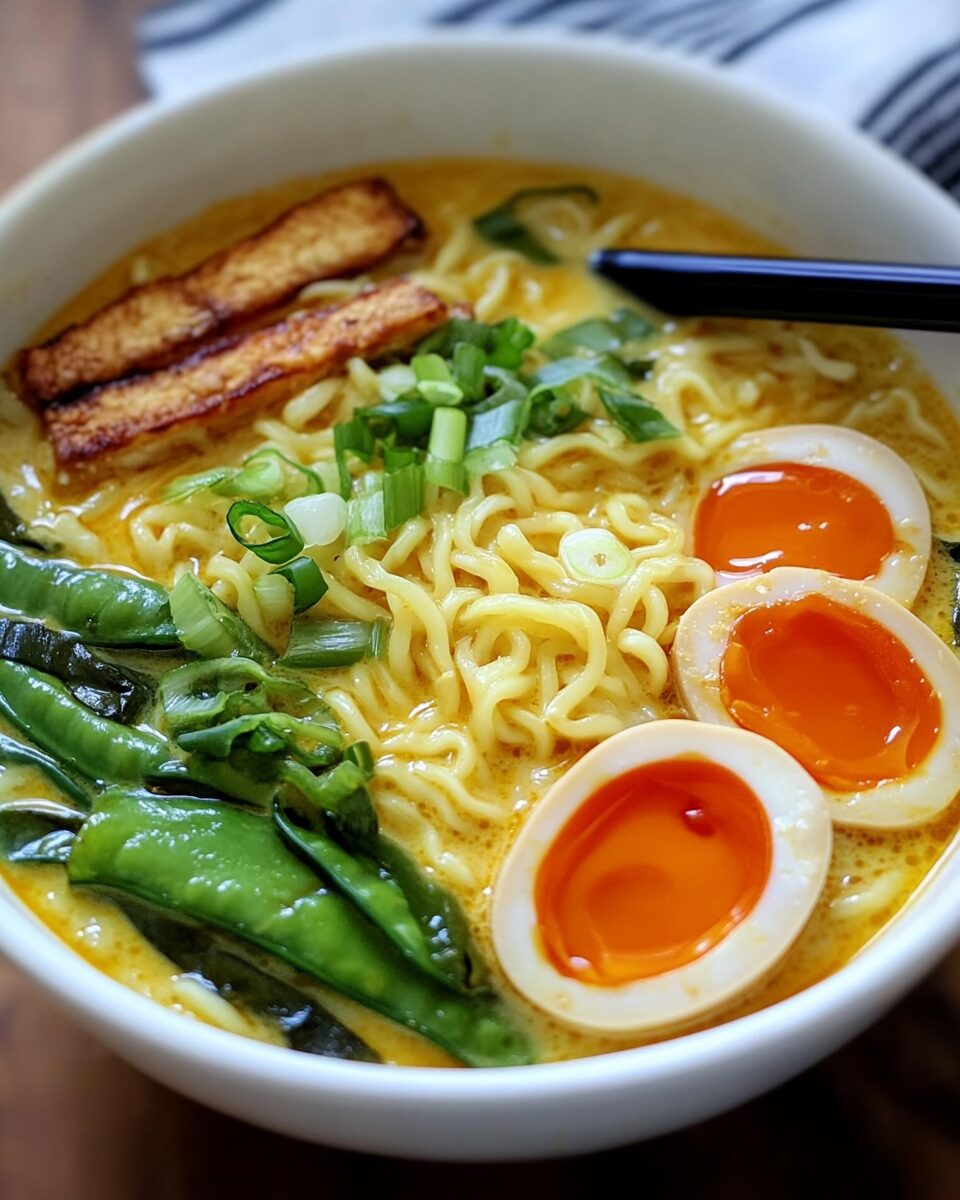When it comes to comforting meals that are both rich in flavor and easy to prepare, coconut curry ramen is an undeniable winner. Combining the creamy, velvety texture of coconut milk with the deep flavors of curry and the satisfying chew of ramen noodles, this dish has earned its place as a favorite among food lovers worldwide. This recipe strikes a perfect balance between comfort food and exotic cuisine, blending Asian-inspired flavors with a hint of tropical flair. But what makes coconut curry ramen so special? To understand, we need to delve into the components that make up this delicious dish and explore why it’s quickly becoming a go-to recipe for both busy weeknights and special occasions.
Full Recipe:
Ingredients:
For the Broth:
- 2 tablespoons red curry paste (or green/yellow, based on preference)
- 1 tablespoon fresh ginger, minced
- 2 cloves garlic, minced
- 1 tablespoon soy sauce
- 1 tablespoon sesame oil
- 1 can (400ml) coconut milk (full-fat for extra creaminess)
- 4 cups vegetable or chicken broth
- 1 tablespoon lime juice
- 1 tablespoon sugar (optional, to balance flavors)
- 2 tablespoons fish sauce (optional, for added umami)
For the Ramen:
- 200g ramen noodles (fresh or instant, without the seasoning packet)
- 1 cup mushrooms, sliced (shiitake, cremini, or any variety)
- 1 red bell pepper, sliced thinly
- 1 cup spinach or kale (optional)
- 1 carrot, julienned
- 1/2 cup firm tofu, cubed (or chicken, shrimp, or any protein)
- 2 green onions, sliced
- 1/2 cup cilantro, chopped (for garnish)
Optional Toppings:
- Soft-boiled eggs
- Fresh lime wedges
- Chili flakes or sriracha for extra heat
- Crispy fried shallots or garlic
Instructions:
- Prepare the Broth:
- In a large pot, heat sesame oil over medium heat. Add the ginger and garlic, sautéing until fragrant (about 1 minute).
- Add the curry paste and cook for another minute to release the flavors.
- Stir in the coconut milk, vegetable (or chicken) broth, soy sauce, fish sauce (if using), lime juice, and sugar. Bring the mixture to a simmer and let it cook for about 10 minutes to blend the flavors.
- Cook the Vegetables and Protein:
- Add the mushrooms, red bell peppers, and carrots to the simmering broth. Cook for about 5-7 minutes until the vegetables are tender.
- If using tofu, shrimp, or chicken, add them to the broth and cook until heated through (for shrimp or chicken, ensure they are fully cooked).
- Cook the Ramen Noodles:
- In a separate pot, cook the ramen noodles according to package instructions. Drain and set aside.
- Assemble the Ramen:
- Divide the cooked noodles into bowls. Ladle the coconut curry broth over the noodles, making sure to include the vegetables and protein.
- Top with fresh spinach or kale if using. The residual heat from the broth will wilt the greens slightly.
- Garnish with green onions, cilantro, soft-boiled eggs, and any other desired toppings like chili flakes or lime wedges.
- Serve:
- Serve hot and enjoy your delicious, comforting bowl of coconut curry ramen!
Tips:
- Adjust the spice level by adding more or less curry paste or topping with chili flakes.
- For a vegetarian/vegan version, omit the fish sauce and use tofu or another plant-based protein.
A Dish with Roots in Many Culinary Traditions
Ramen, originally a Japanese noodle dish, has experienced a global explosion in popularity over the past few decades. Traditionally, ramen consists of Chinese-style wheat noodles served in a meat or vegetable-based broth, often flavored with soy sauce or miso, and topped with ingredients such as pork, eggs, seaweed, and green onions. The variations are endless, but at its heart, ramen is a deeply satisfying dish that has transcended its simple origins.
Curry, on the other hand, has its origins in South and Southeast Asian cuisines. It is a blend of spices, herbs, and seasonings, varying widely depending on the region. Thai curries, in particular, use coconut milk to create rich, aromatic sauces that carry a punch of flavor with every spoonful. Coconut milk, with its luxurious texture and slightly sweet undertones, tempers the heat of curry paste while providing depth and body to the dish.
By combining these two iconic culinary elements—Japanese ramen and Thai curry—coconut curry ramen is born. It’s a fusion dish that bridges the gap between the warming comfort of ramen and the bold, spicy, and creamy flavors of curry.
The Richness of Coconut Milk
One of the key ingredients in coconut curry ramen is coconut milk, which plays a critical role in creating the dish’s signature creamy texture and mouthfeel. Coconut milk is derived from the grated meat of mature coconuts and is rich in healthy fats. Unlike cream or butter, which are animal-based, coconut milk is a plant-based alternative that lends both richness and a tropical flavor.
Coconut milk is not only prized for its creaminess, but it also brings a subtle sweetness to the broth, balancing out the spiciness of the curry paste. This balance of flavors is essential to the overall experience of the dish, allowing the spice and richness to complement rather than overpower each other.
From a nutritional standpoint, coconut milk is a good source of healthy fats, including medium-chain triglycerides (MCTs), which are quickly metabolized for energy. It also contains essential vitamins and minerals like manganese, copper, and iron. This makes coconut milk a desirable ingredient for those who want to indulge in a creamy dish without relying on dairy.
Curry Paste: The Spice of Life
The curry paste is where the magic happens in terms of flavor. Whether you opt for red, green, or yellow curry paste, this concentrated blend of spices, herbs, and chilies is what gives the broth its distinct aroma and taste. Red curry paste, the most commonly used variety in this recipe, typically includes ingredients like red chili peppers, garlic, lemongrass, galangal, and kaffir lime leaves. These ingredients come together to create a complex, spicy, and fragrant base for the ramen.
Green curry paste tends to be hotter and more herbal, while yellow curry paste is milder with a slightly sweeter profile. The choice of curry paste allows you to tailor the dish to your own preferences, whether you prefer it to be fiery hot or more mellow and earthy.
Versatility: Customize Your Ramen
One of the greatest things about coconut curry ramen is its versatility. While the recipe itself provides a solid foundation, the dish is incredibly adaptable, allowing for a wide range of personal preferences and dietary restrictions.
Protein Choices: While this recipe includes tofu as a plant-based protein option, it can easily be swapped out for shrimp, chicken, pork, or beef, depending on your preferences. Shrimp adds a touch of elegance to the dish, while chicken or pork can make it heartier and more filling. For vegetarians and vegans, tofu or tempeh works wonderfully, absorbing the flavorful broth and providing a satisfying bite.
Vegetables: This dish is also a fantastic way to incorporate more vegetables into your diet. Vegetables like mushrooms, bell peppers, spinach, and kale add color, texture, and nutritional value to the ramen. The flexibility of the recipe allows you to include any vegetables you have on hand, making it an excellent option for clearing out the fridge or trying out seasonal produce.
Noodles: While traditional ramen noodles work best for this dish, you can experiment with other types of noodles such as soba, udon, or even gluten-free alternatives like rice noodles or zucchini noodles if you’re catering to specific dietary needs.
Health Benefits of Coconut Curry Ramen
Not only is coconut curry ramen a feast for the senses, but it also offers several health benefits, making it a well-rounded dish in terms of nutrition.
- Healthy Fats from Coconut Milk: As mentioned earlier, coconut milk is rich in MCTs, which are believed to support weight management and provide a quick source of energy. The fats in coconut milk can also help improve cholesterol levels by raising good HDL cholesterol.
- Nutrient-Rich Vegetables: The variety of vegetables included in the recipe offers a wealth of vitamins, minerals, and antioxidants. Mushrooms provide B vitamins and immune-boosting properties, while spinach is a great source of iron and folate.
- Anti-Inflammatory Spices: The curry paste contains ingredients like turmeric, garlic, and ginger, all of which have anti-inflammatory properties. These spices can support digestion, enhance immune function, and promote overall health.
- Customizable Protein: The option to add tofu or lean meats like chicken makes it easy to include a good source of protein in the dish, helping to keep you full and satisfied.
Conclusion
Coconut curry ramen is a dish that delivers both comfort and complexity. Its fusion of Japanese ramen and Thai curry creates a harmonious balance of creamy coconut milk, spicy curry paste, chewy noodles, and fresh vegetables. This versatility allows you to make the dish your own, customizing the protein, vegetables, and level of spice to suit your taste.
Not only is it a joy to eat, but it’s also a nutritional powerhouse, offering healthy fats, protein, and a range of vitamins and minerals in one bowl. Whether you’re craving something cozy on a cold day or looking to impress friends with a flavorful, exotic meal, coconut curry ramen is the perfect choice.
With its rich broth, satisfying noodles, and vibrant flavors, this dish is bound to become a regular in your recipe rotation. So the next time you want to indulge in something hearty yet nutritious, give coconut curry ramen a try—you won’t be disappointed!

